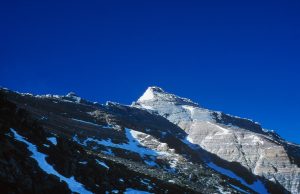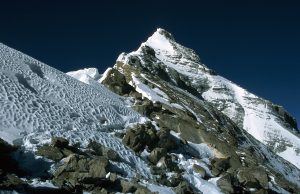Mallory & Irvine’s ascent beyond 8500 m/28,000 ft.
After discarding their first pair of oxygen bottles, Mallory & Irvine would have faced a crucial decision
about the route (see The First Step, © Theo Fritsche; from “Tatort Mount Everest”, p. 129):
- They could have traversed along the top edge of the Yellow Band, thus bypassing the First Step low down. The experiences of later parties have shown that it becomes at least very difficult to regain the Northeast Ridge beyond the First Step, and that a party following this low line is almost certainly forced to traverse into the Great Couloir.
- They could have climbed the First Step either along the ridge or by the open gully in its northern face (i.e. today’s standard route) and continued along the ridge toward the Second Step.
At 12:50 p.m., the two climbers were sighted by Noel Odell as they surmounted a prominent rock step on the upper Northeast Ridge (see Odell’s View – The summit ridge with the First, Second, and Third Steps, © Andy Politz; from “Ghosts of Everest”, p. 116). Odell’s famous sighting has been covered extensively in climbing literature (e.g. Detectives on Everest, pp. 120-123, and Tatort Mount Everest, pp. 112-123), and the surrounding debate will not be repeated here.

Assuming that the essence of Odell’s sighting is correct – i.e. that he did indeed see the two climbers and had not hallucinated or was deceived by an optical illusion (something Odell forcefully denied throughout his life) -, his sighting has been interpreted in two basic ways:
- Odell saw Mallory & Irvine on the ascent. They had chosen the crest of the Northeast Ridge and were either climbing the First or Second Step (or even the Third Step) at 12:50 p.m.
- Odell saw Mallory & Irvine on the descent. On the ascent they had bypassed the First Step low down and subsequently failed to either regain the ridge beyond the step or to cross the Great Couloir. On their retreat they had climbed the First Step for reconnaissance purposes, and were seen doing this at 12.:50 p.m.
With no hard evidence about the route they took beyond oxygen bottle No. 9, both theories carry equal weight. However, circumstantial evidence let me favour the interpretation that Mallory and Irvine were still on the way up when last seen by Odell – and they were not at the First Step.
The reasons are as follows:
- Odell’s diary entry, written within the first six days after his sighting, simply says: “At 12.50 saw M. & I on ridge nearing base of final pyramid.” This strongly suggests a point at or above the Second Step.
- Throughout his accounts written in 1924, Odell remained convinced that he had seen Mallory and Irvine climbing the Second Step. Only in the expedition book, which appeared in 1925, doubts had entered his mind – and with them the possibility that he had seen the climbers on the lower First Step. As Tom Holzel and Audrey Salkeld put it so eloquently in their seminal work (p. 249): “The main reason Odell would cling so tenaciously to the key elements of his vision … is because he cannot do anything else: that is how it was. To have it otherwise, he would need to invent. The inconsistencies in his account only began to creep in when he felt compelled to change the location of his sighting.”
- The topography described in Odell’s accounts doesn’t match the First Step. Odell described one of the climbers appearing on “top of the step”, while the true top of the First Step is never crossed when following any of the routes used to either bypass or climb the First Step.
This last point is obviously the weakest, as the topography described in Odell’s accounts doesn’t fit the Second Step either. Odell described the climbers moving over a “snow patch”. While there is a prominent snow patch at the base of the First Step, the patch at half height of the Second Step is comparatively small and in the shadows most of the day – not an obvious place to spot two climbers. Moreover, Odell’s accounts don’t indicate the climbers belaying or supporting each other, as one would expect on a pitch of such apparent difficulty as the Second Step.
It was for these latter reasons that I considered it for a long time a possibility that Odell had seen Mallory and Irvine at the Third Step (something first proposed in 1981 by Walt Unsworth in his monograph Everest, p. 138), and after my personal observations of climbers on this feature in 1999 I am still struck how surprisingly well they matched Odell’s sighting (see Ghosts of Everest, p. 151, Detectives on Everest, p. 122, and Tatort Mount Everest, pp. 121ff.). However, my opinion has now changed.
